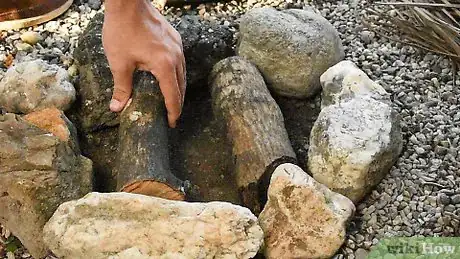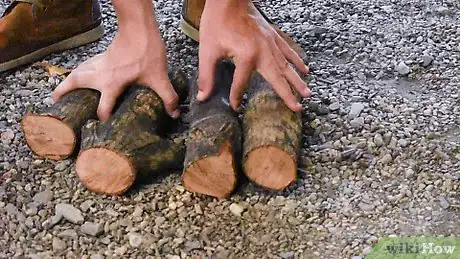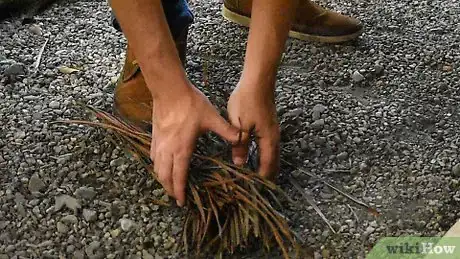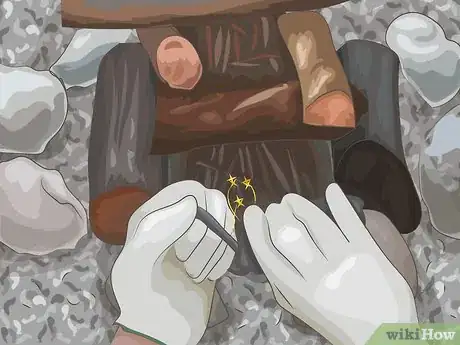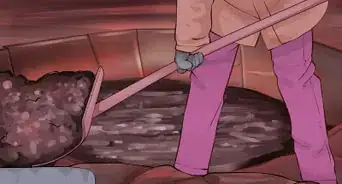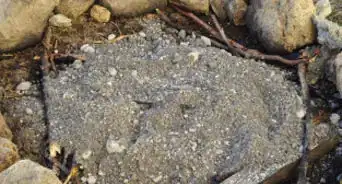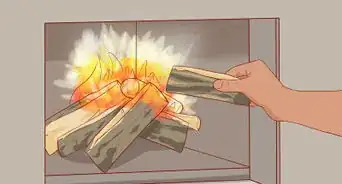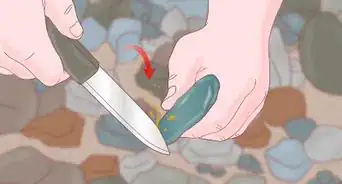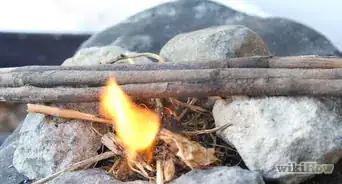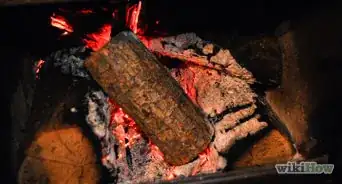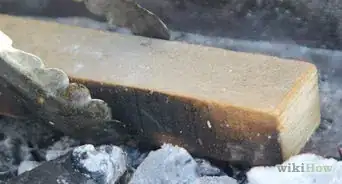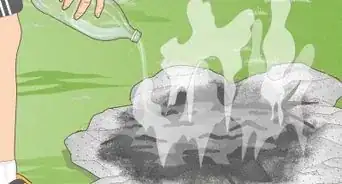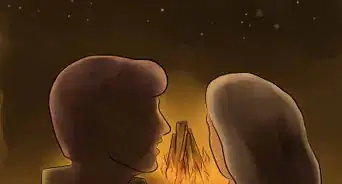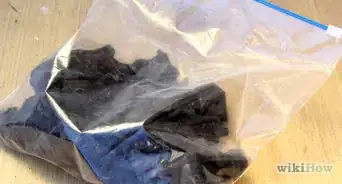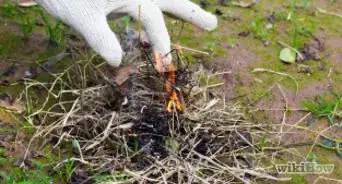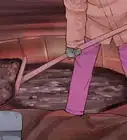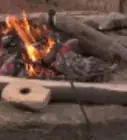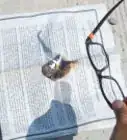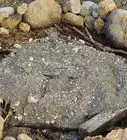This article was co-authored by Britt Edelen. Britt Edelen was an active member of his local Boy Scouts troop near Athens, Georgia from ages 8 to 16. As a Scout, he went on dozens of camping trips, learned and practiced many wilderness survival skills, and spent countless hours appreciating the great outdoors. In addition, Britt worked as a counselor for several summers at an adventure camp in his hometown, which allowed him to share his passion for and knowledge of the outdoors with others.
There are 9 references cited in this article, which can be found at the bottom of the page.
This article has been viewed 2,616,993 times.
You can build a fire fairly easily with the right materials and tools. Gather tinder, kindling, and fuel wood to start and maintain a warming fire. To keep things safe, remember to always build your fire at least 6 feet (1.8 m) away from your tent or shelter as well as low hanging trees. Take the time to put out your fire properly once you are done enjoying it.
Steps
Gathering What You Need
-
1Buy pre-cut firewood to play it safe, if possible. Pre-cut firewood is the ideal option for making a fire at home, and it is also a wise bet for starting a fire outdoors. Having ready-to-use firewood will spare you the time, effort, and uncertainty of searching for usable firewood in the woods. Pre-cut wood logs can be purchased at hardware stores, or from merchants near campsites.[1]
If you are visiting a national park and campground, find out beforehand if they prohibit the use of outside firewood and sell their own pre-cut logs on site, or if they forbid the gathering of firewood on their land.
-
2Use manufactured fire logs for a purely decorative fire. Manufactured logs combine sawdust and paraffin wax for an easy-to-light, clean-burning fire. These logs have the benefit of lighting without any starting material and leaving little mess, but they do not create the same heat as a regular, wood-burning fire would.[2]
- To make an easy fire when you are not in need of warmth, purchase manufactured logs at hardware stores.
Advertisement -
3Find small, dry materials to use as tinder for a natural fire. Tinder is easy-to-light materials that help to start your fire. Find small, dry items such as grass, leaves, shredded tree bark or newspaper are ideal choices. In a pinch, tortilla chips make great tinder if you are willing to spare the snack.[3]
Tip: Some stores sell pre-made tinder. you can also make your own tinder ahead of time.
-
4Find dry, medium-sized items to serve as kindling. Kindling is material that burns easily when it comes in contact with lit tinder, but is difficult to light its own. Look for small sticks, twigs, and large pieces of bark. Make sure that the items are completely dry.[4]
- Cut large pieces of wood with an axe or knife to create kindling.
-
5Collect a variety of fuel wood. Fuel wood should consist of logs that will burn for an extended time and keep your fire alive. Look for dry, brittle wood in a range of different sizes to top off your fire as needed as it burns. Different types of wood burn differently, so keep in mind that:[5]
- Hardwood, like oak and maple, will take longer to start burning but burn for a long time.
- Softwood, like pine and cedar, burns fast and crack and pops while burning due to resins.
Creating a Fire Structure
-
1Build a fire on a clear, dry surface. Choose a spot that is at least 6 feet (1.8 m) away from trees, bushes, and low hanging branches. Clear the area of dry leaves, twigs, or other items that could ignite and cause the fire to spread. Make sure the fire spot is on dry ground, or build a bed of rocks.[6]
- Build a circle of large rocks measuring about 3 feet (0.91 m) or 4 feet (1.2 m) in diameter to mark where you are building the fire.
- Never build a fire anywhere within 6 feet (1.8 m) of your shelter or tent if you are sleeping outdoors.
-
2Build a cross fire structure to keep things simple. Place the tinder material at the center of your fire bed. Next, place kindling on top of it in a crisscross patter. Repeat the pattern with the fuelwood.
Tip: Be sure to leave gaps between the burnable materials when you stack them to allow for airflow so that oxygen can feed your fire.
-
3Make a teepee structure for an easy-to-light option. Bunch your tinder material into a ball that is approximately 4 inches (10 cm) in diameter. Stack pieces of kindling together in a teepee-like shape around the tinder, with an opening on one side. Lean pieces of fuelwood against each other to form a frame around the tinder and kindling, leaving a gap in the same spot that you did for the kindling.[7]
Note: This is an alternative to building a cross fire structure. Don't do both!
-
4Set up a "log cabin" fire structure for easy building. Place tinder material in the middle of your fire site, then build a tinder "teepee" around the tinder material. Place two pieces of fuel wood on either side of the teepee, then lay two more pieces across them, perpendicularly.[8]
- Repeat the pattern 2 to 3 times to build a "log cabin."
- Again, this is an alternative to a cross fire or teepee structure.
Lighting the Fire
-
1Use a lighter or matches, if you have them. The simplest way to light your fire is by using simple fire starters like matches or a lighter. Carefully light matches or strike your lighter and hold the flame to piece of tinder until it starts to burn. [9]
- Gently blow on the lit tinder to help build the fire.
- For the best results, light the tinder from several sides to ensure that it burns properly.
-
2Spark a fire with flint and steel, as a weather-proof alternative. Flint and steel sets are an excellent, lasting, and weather-proof alternative to lighters and matches. Hold the steel and flint close to the tinder pile at the center of your fire bed. Strike the steel against the flint several times to send sparks towards the tinder until it ignites.[10]
- Flint and steel sets are available at hardware stores, sports stores, wilderness supply stores, or online.
-
3Create a fire plough for a makeshift fire starter. Dig a groove into a flat piece of softwood with a pocket knife or another sharp tool. Using a stick or small branch, plough up and down the groove to create friction and heat. After a few minutes, the heat will intensify and ignite the wood particles created by the ploughing motion.[11]
- Other sharp tools that you can use instead of pocket knives include pens, metal skewers, and nails.
Extinguishing a Fire Safely
-
1Start putting the fire out 20 minutes in advance. It takes a while to fully extinguish a fire and it is dangerous to abandon it before you do. Plan when you want your fire to be out to give yourself enough time to achieve this.[12]
Tip: If you have to leave your fire site at a certain time, set an alarm on your phone for 20 minutes prior to remind you.
-
2Sprinkle water over the fire site. Tilt a bucket of water over the fire and distribute drops and small splashes of water onto the embers. Do this gently and gradually. A watering can, large water bottle, or other vessel will also serve to distribute water slowly over your fire site.[13]
Avoid dousing your fire with water, which will ruin the fire site if you want to use it in the near future.
-
3Stir the embers with a stick or shovel while you sprinkle water. Make sure that all the embers in your fireplace get wet by turning them over as you sprinkle water on them. Use a stick or metal shovel to stir them. Be thorough and continue stirring until the fire is extinguished completely.[14]
-
4Make sure that there is no steam, heat, or noise emerging from your fire site. Place your hand near the base of your fire site to make sure it feels cool. If you do not feel any heat emerging from the ground, it is likely to be fully extinguished. Also check for signs of steam and listen for any hissing noises, which are signs of remaining burning embers.[15]
- If you do not see evidence of these things, it is safe to leave your fire site.
- If you see evidence of any of these things, repeat the above steps to extinguish the fire. If you don't plan on using the fire site again, dump water over it.
Expert Advice
Keep these tips in mind when you're starting a campfire.
- Gather enough kindling to keep your fire lit. To keep a fire going for 24 hours, you need a pile of kindling that's the size of a Volkswagen Beetle. Then, to be safe, double that.
- Use a variety of dry materials if you don't have enough sticks. If you're worried about running out of kindling, use things like leaves, pine needles, and dry bark to keep the fire going until you can get more sticks.
- Be strategic with how you feed the fire. To maintain the size and safety of your fire, use smaller sticks when the fire is smaller, then add bigger sticks as the fire goes.
Community Q&A
-
QuestionAre plastic substances safe to burn?
 Community AnswerNo. Burned plastic substances are often toxic to inhale and can cause damage and/or explosions.
Community AnswerNo. Burned plastic substances are often toxic to inhale and can cause damage and/or explosions. -
QuestionWhy does the wood need to be stacked in a pyramid shape?
 Community AnswerFlames burn upward, so when you build a pyramid, the fire will burn up the stick and be less likely to go out from lack of a fuel source.
Community AnswerFlames burn upward, so when you build a pyramid, the fire will burn up the stick and be less likely to go out from lack of a fuel source. -
QuestionWhat's the easiest way to build a fire?
 Community AnswerLayers. Start it with kindling, start adding twigs, then move onto a bigger structure. The classic way is a pyramid, and personally I think it to be best.
Community AnswerLayers. Start it with kindling, start adding twigs, then move onto a bigger structure. The classic way is a pyramid, and personally I think it to be best.
Warnings
- Don't light fires indoors or in extremely dry weather conditions as you could accidentally start a conflagration. Being negligent with fire could also potentially lead to criminal charges.⧼thumbs_response⧽
References
- ↑ http://www.allcampgrounds.com/articles/tips/firewood-for-camping.html
- ↑ http://www.science20.com/science_motherhood/firelogs_vs_wood_fires_whats_right_choice_cozy_winter_fire
- ↑ http://graywolfsurvival.com/2810/build-fire-basics/
- ↑ http://www.wildbackpacker.com/wilderness-survival/articles/how-to-build-a-fire/
- ↑ https://www.wildernesscollege.com/how-to-make-a-fire.html
- ↑ http://graywolfsurvival.com/2810/build-fire-basics/
- ↑ http://www.wildbackpacker.com/wilderness-survival/articles/how-to-build-a-fire/
- ↑ http://www.artofmanliness.com/2008/09/04/how-to-build-a-roaring-campfire/
- ↑ https://www.outdoorlife.com/blogs/survivalist/2014/06/survival-skills-10-steps-light-one-match-fire
- ↑ http://www.artofmanliness.com/2008/04/29/9-ways-to-start-a-fire-without-matches/
- ↑ https://www.fieldandstream.com/photos/gallery/survival/fire/2006/10/seven-ways-light-fire-without-match#page-4
- ↑ http://www.artofmanliness.com/2008/09/04/how-to-build-a-roaring-campfire/
- ↑ http://www.artofmanliness.com/2008/09/04/how-to-build-a-roaring-campfire/
- ↑ http://www.artofmanliness.com/2008/09/04/how-to-build-a-roaring-campfire/
- ↑ http://www.artofmanliness.com/2008/09/04/how-to-build-a-roaring-campfire/
About This Article
To build a fire, start by finding a clear, dry surface. Choose a spot that is at least 6 feet (1.8 meters) away from any trees or bushes. Next, clear the area of dry leaves, twigs, or other items that could ignite and cause the fire to spread. Before you build the fire, make sure you have a plan to put the fire out with water, dirt, or sand. To build a fire, first gather three types of materials: tinder (dry material like shredded bark, leaves, and grass), kindling (small sticks and branches), and fuel wood (larger logs). Make a ball of the tinder material and place it in the center of the area you want to make a fire. Then, stack your kindling around it in the form of a teepee. Alternatively, you can stack the kindling on top of the tinder in a criss-cross pattern. Leave a gap on one side so you're able to easily light the tinder. Once you’ve made the basic structure, lean pieces of fuel wood against each other over the tinder and kindling. Now you’re ready to light your fire. Use a lighter or matches to light the tinder. The tinder should light quickly, but it might help to light it on multiple sides so your fire burns evenly. If the fire isn’t catching, try gently blowing on it to help it spread, since fire needs oxygen to burn. Once the tinder is lit, it should light the kindling, which should burn for long enough that the fuel wood will catch as well. To learn how to start a fire without a lighter or matches, scroll down!
